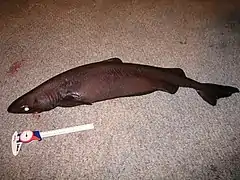Somniosidae
The Somniosidae are a family of sharks in the order Squaliformes, commonly known as sleeper sharks.[1] The common name "sleeper shark" comes from their slow swimming, low activity level, and perceived non-aggressive nature.[2][3]
| Sleeper sharks | |
|---|---|
 | |
| Somniosus microcephalus | |
| Scientific classification | |
| Kingdom: | Animalia |
| Phylum: | Chordata |
| Class: | Chondrichthyes |
| Order: | Squaliformes |
| Family: | Somniosidae D. S. Jordan, 1888 |
| Diversity | |
| 6 genera, 20 species; See text. | |
Distribution and habitat
The Somniosidae can be found in:
- Arctic to subantarctic waters
- Shelves in cold waters
- Continental and slopes
- Temperate and tropical waters[4]
Diet
Beaks recovered from the stomachs of sleeper sharks suggest they feed on colossal squid.[5]
Genera and species
- Centroscymnus Barbosa du Bocage & Brito Capello, 1864
- Centroscymnus coelolepis Barbosa du Bocage & Brito Capello, 1864 (Portuguese dogfish)
- Centroscymnus owstonii Garman, 1906 (roughskin dogfish)
- Centroselachus Garman, 1913
- Centroselachus crepidater Barbosa du Bocage & Brito Capello, 1864 (longnose velvet dogfish)
- Scymnodalatias Garrick, 1956
- Scymnodalatias albicauda Taniuchi & Garrick, 1986 (whitetail dogfish)
- Scymnodalatias garricki Kukuyev & Konovalenko, 1988 (Azores dogfish)
- Scymnodalatias oligodon Kukuyev & Konovalenko, 1988 (sparsetooth dogfish)
- Scymnodalatias sherwoodi Archey, 1921 (Sherwood dogfish)
- Scymnodon Barbosa du Bocage & Brito Capello, 1864
- Scymnodon ichiharai Yano & S. Tanaka (II), 1984 (Japanese velvet dogfish)
- Scymnodon macracanthus Regan, 1906 (largespine velvet dogfish)
- Scymnodon plunketi Waite, 1910 (Plunket's shark)
- Scymnodon ringens Barbosa du Bocage & Brito Capello, 1864 (knifetooth dogfish)
- Somniosus Lesueur, 1818
- Somniosus antarcticus Whitley, 1939 (southern sleeper shark)
- Somniosus longus Tanaka, 1912 (frog shark)
- Somniosus microcephalus Bloch & J. G. Schneider, 1801 (Greenland shark)
- Somniosus pacificus Bigelow & Schroeder, 1944 (Pacific sleeper shark)
- Somniosus rostratus Risso, 1827 (little sleeper shark)
- Somniosus sp. A Not yet described (longnose sleeper shark)
- Zameus D. S. Jordan & Fowler, 1903
- Zameus squamulosus Günther, 1877 (velvet dogfish)
Hákarl
Greenland sharks of the family Somniosidae are hunted for food in Iceland. In modern times, many Greenlandic sharks used for hákarl production are purchased from fishing ships where the sharks were trapped in the fishing nets. The shark carcass is traditionally fermented in a shallow pit, with stones placed on top of the shark, allowing poisonous internal fluids, like urea and trimethylamine oxide, to be pressed and drained out of the body. The meat is then cured for several months, rendering it safe for human consumption.[6]
References
- Froese, Rainer, and Daniel Pauly, eds. (2011). "Somniosidae" in FishBase. February 2011 version.
- Erin McCarthy (December 18, 2014). "7 Cool Facts About Greenland Sharks". MentalFloss.com. Retrieved August 17, 2016.
- Bruce A. Wright (December 8, 2000). "Sleeper Sharks Not So Sleepy". Arctic Science Journeys, University of Alaska Fairbanks. Retrieved August 17, 2016.
- "Family Somniosidae - Sleeper sharks". Fish Base. Retrieved 29 December 2012.
- Cherel, Y. & G. Duhamel 2004. "Antarctic jaws: cephalopod prey of sharks in Kerguelen waters" (PDF). (531 KB) Deep-Sea Research Part I 51: 17–31.
- Wheatley, Gale (20 September 2010). "Iceland's Wild Culinary Traditions: Hákarl and Brennivín".


